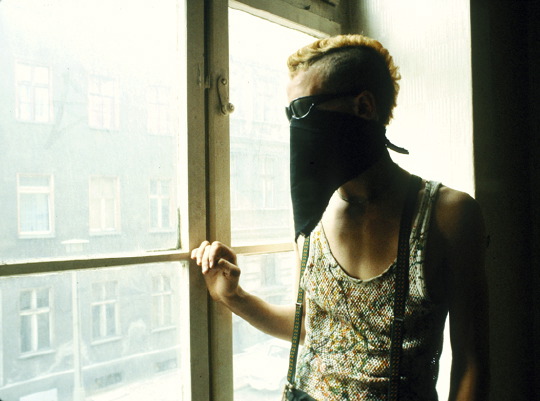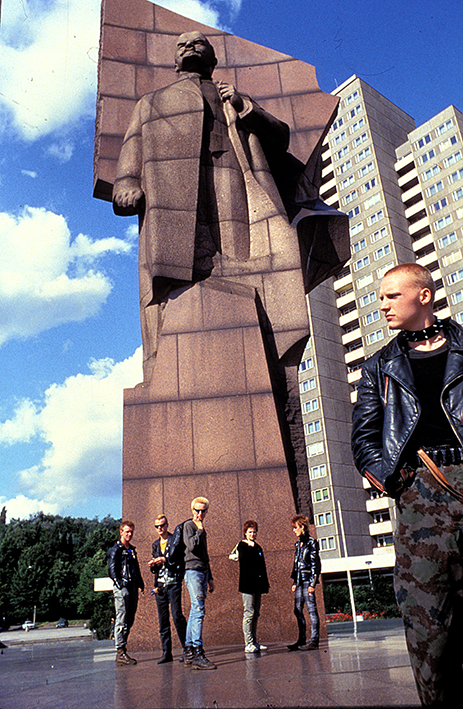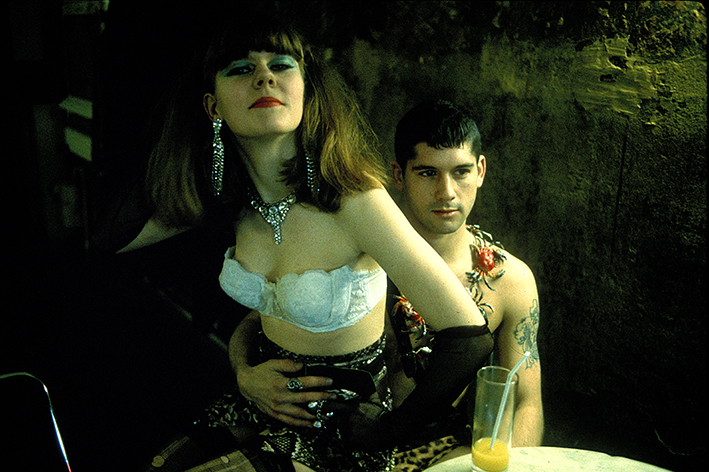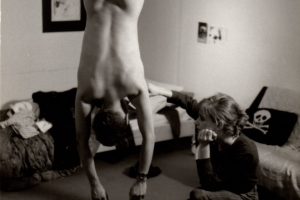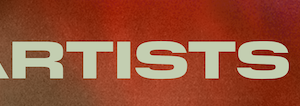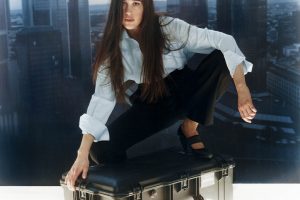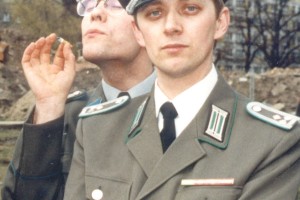ILSE RUPPERT: “People have become very conscious of their image”
Ilse Ruppert is a German photographer that has been active since the middle of the 70s. Child of the twentieth century, she grew up in a small town in West Germany and saw her life radically change with the discovery of rock’n roll during a Screaming Lord Church show. Looking for adventure and new music, she traveled the world and ended up in London, where she discovered photography. After having cut his teeth in Downtown New York in the late 1970s, she moved to Hamburg and found herself thrown into the heart of the german punk explosion of which she became one of the main archivists. From 1983, she shared her time between Paris, Los Angeles and Berlin and documented the different urban tribes that populated these cities. Since the late 90s, she’s been living in Berlin where she continues to work.
Where do you come from?
I grew up in a small town in West Germany, near Frankfurt. As soon as I could, I went to Frankfurt, and then to Munich. It was the early 70s and there was a lot going on things over there: hippie culture, communes … I didn’t really know what I wanted to do and I was eager for adventures, so I started to travel around: I lived a few months in Mexico, Morocco, London …
How did you get into photography?
I was in London with a Mexican friend who was studying photography at Royal College of art. I was lying on the floor in front of a candle and he took a picture of me. A few days later he gave me a black and white print, and I immediately fell in love with it: that was what I wanted to do: Photography! I went back to Munich, bought a Nikomat and applied to the school of photography but didn’t get accepted because I didn’t have any experience. I was naive. But I did not dismantle; I found an internship with the photographer of the Residenztheater Munich and there I learned black and white techniques and soon after left for New York.

DAF – Hamburg Markthalle 1981 (Photo: Ilse Ruppert)
Why New York?
I found american photographers very strong and I wanted to understand their way of working. I then went to live there for six months, in 1978.
Was New York an important moment for?
Yes. It was there that I learned that it was necessary to build a personal archive. This trip also launched my career, everything was easy: one evening I met Ernst Haas (photographer from the Magnum agency) in a party: ”Girl, what are you doing in NY? Ah! you’re a photographer? Come then! He then took me to see the DA of a newspaper and five minutes later I had an order of six double pages on the Germans in New York! Thanks to this order I met people from all walks of life: punks, ambassadors…
New York was very exciting, I lived next to the Mudd club and went out every night. It’s here that I took a picture of Klaus Nomi and, without knowing who it was, John Lurie.
You speak of archives. Your photos constitute a real archive, even a mythology of West Berlin and the German punk scene. Were you aware of all this at the time?
It later became a mythology but it was not the original intention. It was also my life, I only photographed people I loved, bands that I loved. If I didn’t like a group, I could not photograph it, there had to be passion.
How did you end up photographing this scene?
On my return from New York, I was again in Munich which was the center of the press in Germany but where the photo market was limited to women’s stores magazine like Marie Claire. I then went to Hamburg, which was along Berlin the capital of punk in Germany. This is where I met Mona Mur, who shared a flat with FM Einheit, people of the Abwärts group, Christiane F …, so I was able to photograph the whole scene. Mona became my best friend and together we did the report on the punks of East Berlin.
- John Lurie and friend – Mudd Club NYC 1978
- DEAD KENNEDYS playing at the Whisky a GoGo in Los Angeles
- Mona Mur – musician Hamburg 1981
Can you talk about your report on East Berlin?
I often went with Mona to West Berlin and we were wondering how did the young people of East Berlin live: where did they go out? What did they listen to? I thought that if this interested me, it probably also interested people of my generation. We then contacted “Konkret” magazine from Hamburg, who liked the project. Since they were a leftist magazine, they had connections with the GDR and a week later we were in East Berlin, which was amazing because normally it was very difficult to obtain authorization. The visual atmosphere was very heavy, the power in place had left most of the city in the same condition as in 1961.
While we were driving back from the embassy, we passed a punk in a phone booth. A punk! I would never have imagined this. I stopped the car and ran to him to take a picture, but a VoPo * (Volkspolizei) located next to the cabin, confiscated my device and took us to the station. I then asked the punk to wait for us and 2 hours later we met him. The situation was intense; in the GDR at the time, a punk could be arrested for nothing. There was a guy from STASI who constantly accompanied us. We were finally able to get rid of him by getting him drunk and joined the punks in their Prenzlauer Berg squats. It was crazy, there was not much difference with the West Berlin punks. They listened to almost the same music, same graffitis on the walls, the same mess, their punk look too was very creative. The next day, we made an appointment with the punks on the “Platz der Vereinten Nationen ”in Friedrichshain, where there was the Statue of Lenin.
I removed the motor from my device in order to pass for a tourist, the punks posed and we did the photos, which very quickly went around the world. In the article for ”Konkret”, I also showed the official youth of East Berlin, but it is the image of the punks in front of the Lenin sculpture that stayed.
How did the GDR react to the “Konkret” feature?
Wrong! The pictures of the punks put me on the GDR red list. I had to wait the fall of the Wall to be able to return to the East. Years later I realized that the STASI had us observed while the shots were being taken and they used my pictures to show to the Police what a punk looked like. They were in the crosshairs of the Stasi who did not want rebellion. Punk shows were held in churches, because these were the only places where the police could not intervene. Irony is that a lot of eastern punks were kids of senior party officials, and some punks were spies of the Stasi.
Can you tell us about West Berlin?
In the 80s, I was in Berlin very often but didn’t live there, the food was too disgusting! (laughs). I only moved there in the late 90s. At the time of the Wall, West Berlin was like an island surrounded by Kalashnikovs. There was a constant tension there. To join the city, we sometimes had to wait up to 6h. It was also the only city from Germany exempt from military service, which led young germans to search exile in Berlin. Most of my friends lived in squats; sometimes we would be at the terrace of a cafe we would hear the sirens of the police and wondered if some of us would come face to face with them after finishing their beer …
It was also a party town, everything was open 24 hours a day. Our evenings started around midnight. Drugs were everywhere: one evening we were at a friend’s house and we no longer had anything to smoke. She then pulled on a rope and the neighbor from the 3rd floor sent down a basket with equipment … (laughs) Rumor has it that synthetic drugs (speed, LSD …) which then circulated in Berlin-West were produced by the GDR, which sought to destabilize the West. Recently I learned that they had also funded the RAF, that was a shock to me.
How did you experience the fall of the Wall?
When the Wall fell, I was in Paris, having dinner with a german friend. The waiter came to see us and announced the news. We didn’t know what to do. I had goosebumps. We finally decided to go to the GDR embassy at Blvd. St Germain but there was nothing, everything was closed.
We often hear West Berliners say they regret the wall. What do you think?
I don’t regret the Wall, it was something horrible, but on the other hand I think reunification doesn’t work. East and West Germans are too differents, we lack common reference points. The only place where I findthat the difference is erased is Mitte, but because it has become an open sky shopping center, a generic district, a pure product of capitalism.
- Joy Ryder from NYC on exile in West-Berlin 1981
- Blixa Bargeld pictured at TV-Producer Jörg Hoppe Birthday Bash, held on a ship on the river Spree, 1984 in Westberlin.
- Christiane F. in her room, Hamburg, Hein-Hoyer-Strasse
After Hamburg, you lived between Paris and Los Angeles. what have you doing there?
In 1982, I met my future husband actor Tcheky Karyo and came to join him in Paris. I kept going back and forth with Germany. Apart from a few groups like the Rita Mitsouko, the French music scene was very mundane. So we decided to spend winters in Los Angeles, finally meeting american cinema… There, I was hanging out at Madame Wong’s, a Chinese restaurant in Chinatown where East LA punk scene was hanging out. I was working a lot. The first person that I photographed there was Hubert Selby Jr., author of the book “Last exit to Brooklyn”. I simply called him and offered a session, and he accepted. This is something that I had learned with Frank Zappa in the 70s: you always have to ask. If you don’t ask how do you expect to get?
When you look at your pictures, we notice that the music is there is very present, via the musicians you photographed, but also through the youth subcultures, the “tribes” that you have documented.
Yes I have a real love for music, It has shaped my life. When I was 17 years old I took traditional dance lessons. In Mexico, I went out dancing Tango, the Chachacha … Later I went to Brazil in a samba school. When I lived in Munich, I was listening to a lot of jazz and salsa. My boyfriend at the time was a saxophonist in a free jazz group. For me, free is jazz punk. In New York I really liked the music of James Chance, Klaus Nomi, B52, Talking Heads,…
The energy of the music is reflected in your photos, which are very dynamic. Did you have a predilection for black and White?
As for the music, yes, I wanted to transcribe the intensity of what I was experiencing the same way I was experiencing the vibrations of the music that surrounded me. Magazines back then only wanted color photo, but my real passion is for Black and White.
And how did you work?
From the start, one of my principles was to work with available light. Later in Paris I worked in studios but I preferred by far working outside, with the place and the moment. Sometimes I used the flash when I really had to, like when I took the picture of Blixa Bargeld, at a party on a boat where everything was very dark. I had fairly simple equipment: a few optics (a 24mm, a 35mm, a 50mm, a 90mm) and two 24×36 box with motors. First a Nikomat, then later Leica cameras. Today I have a digital Leica which I am very happy with.
Has digital changed the way you work?
No. I walk around, I watch and I wait for the right time to trigger.
- Punks vor Lenindenkmal in Ostberlin;1982
- Ost-Punks im besetzten Haus 1982
What are you doing today as a picture?
Today I no longer work for the press, I focus on maintain my archive. But I still have plans. I continue to photograph when I go out and I wait for images to come to me. I have always liked to photograph people. I am passionate about people. I am interested in the energy that get off “real” people. Often I create chaos around me, which allows my subjects to forget themselves and to be themselves on the image. I remember a session I had to do in my studio in Paris with a German band. I bought something to drink and to smoke. I invited people and the shoot became a party, and like that I was able to have my photos!
(to laugh)
You often say that you ask and people say yes to you, but when you take pictures of people in the street, do you also ask?
No. Sometimes I ask, but afterwards (smiles). However, I notice that people’s attitudes have changed over the years. It’s much more complicated to photograph the street today. People have become very conscious of their image.
Often your images can be linked to fashion – but not high fashion, more likely that of the street –, as an archive of the pop culture of the last 40 years. Do you feel close to the documentary approach of photographers like Walker Evans?
No, not really. It is true that my photos have a link with fashion, but what interests me is fashion as a mean of expression of the street, authentic cultural fashion. In the 80s there were a lot of urban tribes, and this is what I loved to document. So yes these are fashion photos on a daily basis, they constitute a popular archive.
Often photography is seen as a voyeuristic activity, do you agree with that view?
Yes, absolutely, but photography has also allowed me to live adventures. For me, the real thing was going to meet bands. I prepared very little for my shootings, it is in the pressure of the moment that I found the angle, like improvisation in music, I trusted my intuition.
Which photographers have influenced you?
Diane Airbus, Helmut Newton, Eliot Erwin, Tina Modotti … and also in a way painters like Goya, Dali, Max Ernst, H. Bosch.
What interested you about them?
For example, some of Goya’s gouaches are like a pause, as for Dali and Max Ernst: the inexplicable secrets … Regarding Eliot Erwin: the offset and the humor; and Tina Modotti: Adventure and Elegance. The genialer dillettante scene recalls at the same time the bauhaus, dada, expressionism …
How did you relate to the squat scene?
I’ve photographed the squats a few times, but with the RAF? None!
It seems there’s an esoteric dimension in a lot of records coming from the Geniale Dilletanten Szene (genius diletante scene), and also in some of your images, jut like with the art produced in Berlin in the 1920s. Is there a German esoteric heritage? A secret history of German culture?
I don’t know about that, but there are influences from Weimar. At the start of the Weimar era, cinema was synonymous with films dumb. Expressionist films featured intrigue exploring the dark side of human nature. I loved Expressionist set designs, the style was typically nightmarish in the atmosphere. When I was growing up in the 1950s, the pictures in newspapers and magazines were still very much in this tradition; photographs posed with light settings in black and white. I was quite impressed with the romance, the fantasy and raw emotion; especially with the portraits of stars of cinema and theater.
What do you think of Angela Merkel?
I respect her a lot, but I did not vote for her party.







